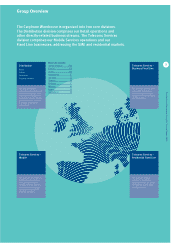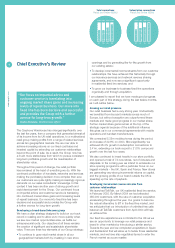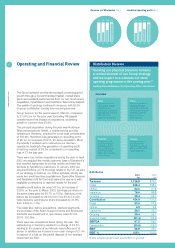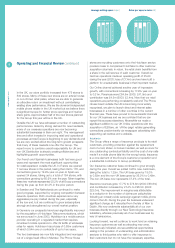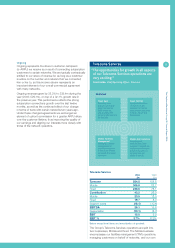Carphone Warehouse 2004 Annual Report Download - page 15
Download and view the complete annual report
Please find page 15 of the 2004 Carphone Warehouse annual report below. You can navigate through the pages in the report by either clicking on the pages listed below, or by using the keyword search tool below to find specific information within the annual report.
The Carphone Warehouse Group PLC Annual Report 2004
13
Net borrowings peaked during the year at £166m mainly
as a result of acquisitions and high working capital levels
during the peak Christmas trading period. The Group seeks
to maintain comfortable headroom on committed facilities
at all times and all future contractual commitments can be
covered by the existing facilities.
The Group also has a number of uncommitted loan
facilities, overdrafts and guarantee lines, all technically
repayable on demand, which enable it to optimise cash
management efficiency particularly at times of peak
working capital requirements. Surplus cash that cannot
be utilised to offset other Group debt, or which is ring-
fenced for insurance purposes, of £42.6m at the period
end (2003: £34.2m), is invested to maximise returns whilst
ensuring at all times that such investments are within
acceptable risk parameters.
Funding of our subsidiaries is arranged and monitored
centrally. All cross-border funding is provided on an
arm’s length basis and currency risk is hedged using
foreign exchange swaps or currency borrowings, as
appropriate, at all times. Balance sheet translational risk
is not specifically hedged against adverse movements
in exchange rates and the results of any such movements
are taken to reserves. The Group is exposed to limited
cross-border transactional commitments and, where
significant, these are hedged at inception using forward
currency contracts.
Treasury policy permits the use of long-term derivative treasury
products for the management of currency and interest rate
risk; however, with the current low levels of Group debt,
almost all debt is liable to floating rate interest. The interest
cover covenant was comfortably exceeded at the period end
and, whilst low levels of debt persist, movements in interest
rates will have a limited impact on Group profits. The Group
does not trade or speculate in any financial instruments.
Accounting policies
The accounting policies adopted during the period are set
out on page 30 and are consistent with those applied in the
prior period with the exception of UITF 38 which was
applied in this period and gave rise to a prior period
adjustment as detailed in note 12 to the financial statements.
International Financial Reporting Standards
The Group will be required, subject to enabling UK legislation,
to adopt International Financial Reporting Standards (IFRS)
for the year ending 1 April 2006. The Group will continue to
assess the impact of adopting IFRS on an ongoing
basis given that both UK and International Standards are
undergoing a period of rapid change to assist harmonisation.
Return of capital employed
Total shareholders’ funds at 27 March 2004 were £471.8m,
compared to £455.6m at March 2003. After taking into
account average net debt, and adjusting for goodwill
amortisation on acquistions and minorities, the Group
generated a return on capital employed of 17.6%
(2003: 17.2%).
Assuming a weighted average cost of capital for the period
ended 27 March 2004 of 7.1% (2003: 7.0%), this
represents an increase in economic value added from
£26.8m to £37.8m, being 10.2% and 10.5% respectively.
Roger Taylor, Chief Financial Officer
Cash generation is a prime objective
of the Group and we expect to generate
significant levels of free cash flow in
the future, allowing us to reinvest
in the growth of the business and pursue
a progressive dividend policy.


